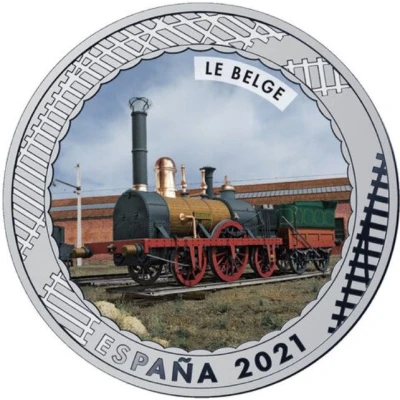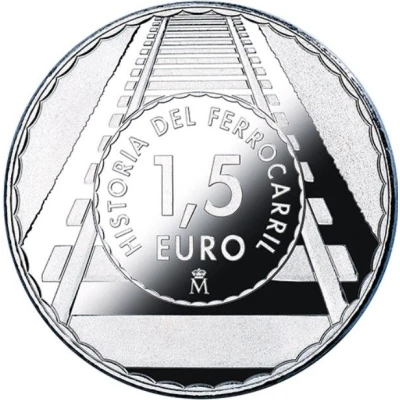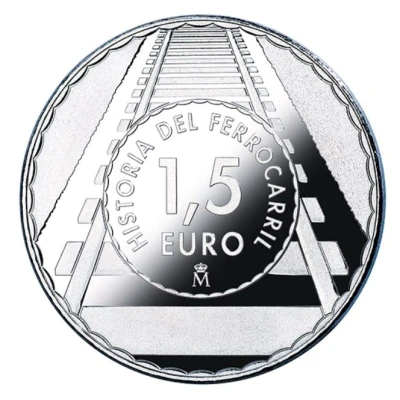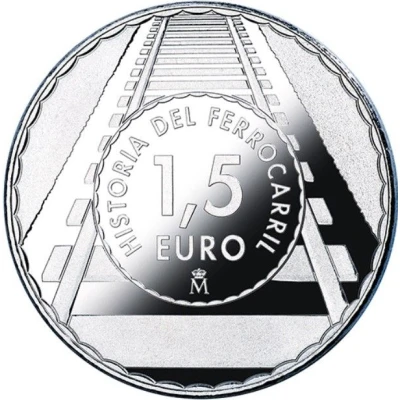


© Real Casa de la Moneda
1.5 Euro Le Belge
2021 year| Copper-nickel (75% copper, 25% nickel) | 15 g | 33 mm |
| Issuer | Spain |
|---|---|
| King | Felipe VI (2014-date) |
| Type | Non-circulating coin |
| Year | 2021 |
| Value | 1.5 Euro 1.50 EUR = USD 1.65 |
| Currency | Euro (2002-date) |
| Composition | Copper-nickel (75% copper, 25% nickel) |
| Weight | 15 g |
| Diameter | 33 mm |
| Shape | Round |
| Technique | Milled, Coloured |
| Orientation | Medal alignment ↑↑ |
| Updated | 2024-10-07 |
| Numista | N#320576 |
|---|---|
| Rarity index | 92% |
Reverse
Series and face value inside a central circle. Outside the central circle, an image of a railway track.
Script: Latin
Lettering:
HISTORIA DEL FERROCARRIL
1,5 EURO
M
Translation: History of railways
Edge
Plain
Comment
For the year 2021, since the European Year of the Rail and the 80th Anniversary of Renfe are celebrated, the FNMT-RCM issues a collection of 20 coins dedicated to the History of the Railways. This series reproduces a selection of trains and locomotives that have been relevant throughout its history.Le Belge: Belgium was the first country on the European continent to have a railway. Its first line, running from Brussels to the nearby town of Mechelen, was inaugurated on 5th. May 5 1835. At the solemn ceremony, three convoys were set in motion, hauled respectively by the locomotives La Flèche, Le Stephenson and l'Élephant. The event was attended by George Stephenson himself.
Although Belgium’s first five steam locomotives were supplied by Robert Stephenson & Co., the sixth, known as Le Belge, was made that same year by the Société Anonyme John Cockerill, thus becoming the first Belgian locomotive and also the first to be made on the continent of Europe.
Of Scottish ancestry and residing in Lièges since 1807, John Cockerill founded his factory in 1817 to make textile machinery, branching into the production of steamboats and gunboats in 1820 and locomotives and rails in 1835. The haste with which Belgium undertook the production of locomotives is reflected in the fact that, by1839, 66 percent of the units running on its networks had been made by Belgian companies.
Le Belge, which left the Seraing factory on 30th December 1835, not long after the inauguration of the Brussels-Mechelen line. It was the first in a series of eight units and was characterised by having a single driving axle with a wheel 1,524 mm in diameter. Clearly influenced by British designs, it is also worth noting that its two cylinders were located internally in a horizontal position, beneath the smokebox. The chimney was topped with a fender in the shape of an inverted basket so as to prevent incandescent ashes from escaping. Its working pressure was 4 kg/cm2 and the maximum power was 50 hp.
Interesting fact
The 1.5 Euro (Le Belge) 2021 coin from Spain made of Copper-nickel has a unique feature - it has a color-changing feature. When exposed to heat, the coin's center piece changes color from silver to gold, creating a beautiful and eye-catching effect.
Price
| Date | Mintage | VG | F | VF | XF | AU | UNC |
|---|---|---|---|---|---|---|---|
| 2021 M | 7000 | - | - | - | - | - | - |
Values in the table are based on evaluations by sales realized on Internet platforms. They serve as an indication only for 1.5 Euro (Le Belge) 2021 coin.



